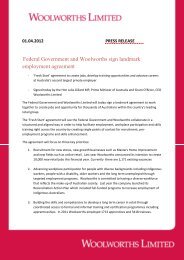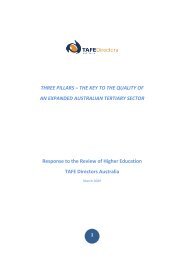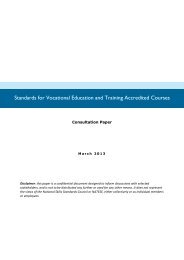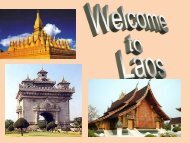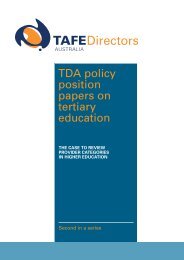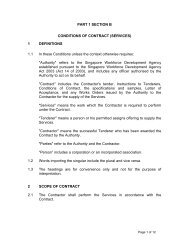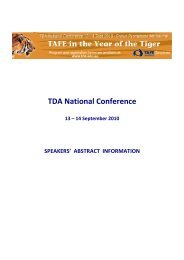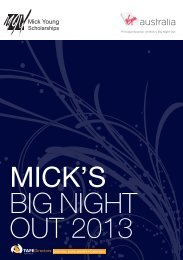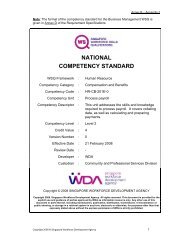Occasional Paper - TAFE Directors Australia
Occasional Paper - TAFE Directors Australia
Occasional Paper - TAFE Directors Australia
You also want an ePaper? Increase the reach of your titles
YUMPU automatically turns print PDFs into web optimized ePapers that Google loves.
60<br />
International students and<br />
skilled migration:<br />
re-appraising the relationship<br />
• How are we managing the relationship<br />
between migration and education<br />
• How are we managing the impact of recent<br />
changes to government policy on students/<br />
providers<br />
• Decoupling education and migration: what are<br />
the right settings<br />
MARK CULLY<br />
Chief Economist, Department of Immigration<br />
and Citizenship<br />
After graduating with an Honours degree in<br />
Economics from Adelaide University,<br />
Mark was a public servant in Canberra, a<br />
Commonwealth Scholar at the University of<br />
Warwick and a civil servant in Whitehall.<br />
While head of research on industrial<br />
relations for the UK Government in the late<br />
1990s, he ran what was the world’s largest<br />
survey of working life, which was the basis<br />
for his second book, Britain at Work.<br />
In 1999, he joined the National Institute of<br />
Labour Studies at Flinders University, and<br />
was then General Manager at the National<br />
Centre for Vocational Education Research for<br />
six years, running its statistical and then<br />
research operations. Mark was a speaker at<br />
the inaugural Adelaide Festival of Ideas in<br />
1999 and chaired the advisory committee<br />
which prepared the Festival program from<br />
2003 to 2007. He joined the Department in<br />
January 2009 as its inaugural Chief<br />
Economist.<br />
Synopsis<br />
<strong>Australia</strong> has been a pioneer in the large-scale<br />
provision of international education. In absolute<br />
terms, <strong>Australia</strong> sits fourth in the world, while on<br />
a per capita basis it is (most likely) first. During<br />
2009, there were close to half a million international<br />
students in <strong>Australia</strong>, up more than three-fold from<br />
ten years earlier. There are distinctive features that<br />
underwrote this boom, notably allowing students to<br />
transition to permanent residence while onshore.<br />
Some accounts examine the international student as<br />
sovereign consumer, free to choose which country<br />
offers the best experience and cost package. The<br />
approach I take is from a different perspective,<br />
that of the sovereign state. It is the state which<br />
determines whether to allow international students<br />
passage to enter and live in its territory, and under<br />
what conditions. At heart, the state must consider<br />
how the national interest is served by international<br />
students. There are three different roles that<br />
international students play in the host country:<br />
consumers of education services; members of the<br />
resident population; and putative skilled migrants.<br />
Within this framework, the <strong>Australia</strong>n experience<br />
between 1998 and 2008 can be characterised as a<br />
commercialisation phase, one where the national<br />
interest coalesced with the self-interest of education<br />
providers in favouring growing numbers of students.





